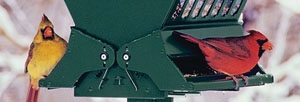Blog - General
Myths and Misconceptions
Some common myths and misconceptions about feeding birds
A recent article once again raised the issue of birds becoming dependent on backyard bird feeders especially during the winter months. Birds do not rely on any one sing le food source. Their ability to forage for a variety of foods under various conditions along with the uncanny ability to adapt to changes has proven to be a successful survival instinct over millions of years. What birds cannot adapt to is the loss of habitat which is the number one cause for the rapidly declining populations of many bird species which is not a myth but a fact. Here are some common myths associated with backyard bird feeding:
le food source. Their ability to forage for a variety of foods under various conditions along with the uncanny ability to adapt to changes has proven to be a successful survival instinct over millions of years. What birds cannot adapt to is the loss of habitat which is the number one cause for the rapidly declining populations of many bird species which is not a myth but a fact. Here are some common myths associated with backyard bird feeding:
- Myth: Birds become dependent on bird feeders.
Fact: While the same birds may regularly visit feeders as part of their daily foraging, studies have shown that wild birds only get an average of 25 percent of their food from feeders. There are many wild food sources that birds prefer and while they will visit feeders out of convenience, they are well able to find other sources of food if feeders are unavailable. Feeders may become more critical during harsh winters, but birds will not starve if the feeders aren’t filled. We do however recommend during these extreme weather events you keep your bird feeders filled as snow and ice may cover up much of the natural foods for a period of time.
- Myth: If birds eat uncooked rice, it can swell up in their throats or stomachs and kill them.
Fact: Plenty of birds eat uncooked rice in the wild. Bobolinks, sometimes called “rice birds,” are a good example. While rice is okay for birds, many wedding parties now throw bird seed instead.
- Myth: Birds can choke on peanut butter.
Fact: There is no documented evidence for this. However, mixing peanut butter with grit or cornmeal will break up the stickiness if you are concerned.
- Myth: Birds’ feet can stick to metal perches.
Fact: This is not likely. A bird’s legs and feet are made up mostly of tough tendons that have little blood flow during cold weather. However, we’ve heard rumors of feet sticking to perches: if you observe this unfortunate circumstance, please take a picture and send it to Project Feeder Watch.
- Myth: Feeding Birds in the Fall Keeps Them from Migrating
Fact: Many inexperienced birders assume that as long as there is food available, the birds will be there, and that feeding them will interfere with the birds’ migration. While some bird species, such as American robins and waxwings, are nomadic with relation to their food sources, birds that migrate depend on the weather, daylight and their own genetic instincts to begin migration. Instead of keeping birds from migrating, available feeders actually give them a much needed energy boost to help them survive their long journeys.
- Myth: You Don’t Need to Feed Birds in the summer
Fact: While there are more natural food sources available during the summer months, including flowers, insects, fruits and natural seeds, these are the same months when parent birds are overworked trying to provide for hungry broods and growing nestlings. Supplemental food from feeders is an easy and convenient resource for many summer birds, particularly at a time when there are more birds around to compete for the same food sources. By feeding the birds in the summer, you’ll enjoy many more species in your backyard and will “teach” young birds where to return the following year for a reliable food source.
